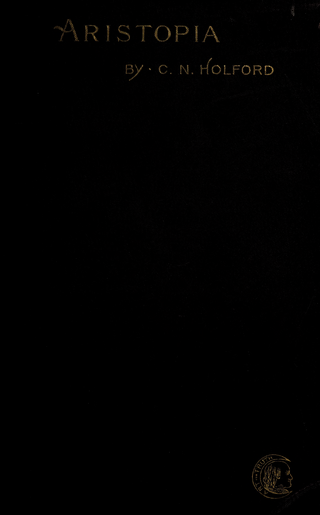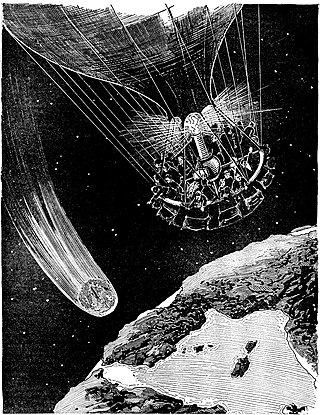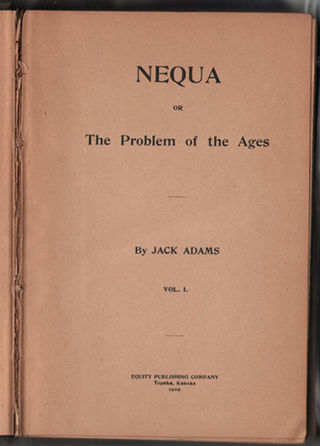| Author | Anna Adolph |
|---|---|
| Country | United States |
| Language | English |
| Genre | Adventure fiction Fantasy Speculative fiction Utopian fiction |
| Publisher | Privately printed |
Publication date | 1899 |
| Media type | Print (Hardcover) |
| Pages | 80 |
Arqtiq: A Story of the Marvels at the North Pole is a feminist utopian adventure novel, published in 1899 by its author, Anna Adolph. [1] The book was one element in the major wave of utopian and dystopian fiction that marked the later nineteenth and early twentieth centuries. [2] [3] [4]
Arqtiq participates in, bridges, and hybridizes several related literary genres and subgenres of its time. Some writers applied feminist viewpoints to utopian fiction; Elizabeth Corbett's New Amazonia is one pertinent example, among others. A number of late-nineteenth-century novels looked forward to the invention of the airplane, as Adolph's book does; these works can be classed, at least generally or peripherally, as science fiction. Arqtiq combines this "airplane fiction" with utopian feminism, as does Jones and Merchant's Unveiling a Parallel .
Arqtiq also partakes in the exotic subgenres of hollow Earth or subterranean fiction, and lost-world or lost-race fiction. [5] Like Mary Lane's Mizora , Adolph's Arqtiq gives these forms of adventure fiction a feminist twist.
Stories of travel to the North Pole or South Pole recurred throughout the nineteenth century. Edgar Allan Poe's The Narrative of Arthur Gordon Pym of Nantucket is the most famous of these; there were various others.
Finally, Adolph couches her story as a dream, linking it to a whole host of fantasies that employ the dreaming motif.
The plot of Arqtiq involves a woman who invents an aircraft, a sort of hybrid of airplane and balloon. She decides to fly it to the North Pole, accompanied by her husband, father, and friends (characters based on the author's own relationships [6] ). After crossing the continent to New York, they travel northwards and reach the Pole. At first they perceive only a flat plain surrounded with icebergs; but the narrator detects a crystal city beneath the ice. The aeronauts land and meet the inhabitants, called the Arq. The Arq maintain a culture of gender equality and high technology. Communication is facilitated by the Arqs' telepathy; the narrator soon develops the same psychic ability. Despite their isolation, the Arq are devout Christians.
Adolph's Arqtiq has been characterized as "An eccentric novel combining elements of science fiction and religious fundamentalism," and an "exuberantly incoherent" book that also touches upon the work of John Symmes, a lunar meteorite, and "lunar people who are tiny and nasty." [7]
Fantasy comedy or comic fantasy is a subgenre of fantasy that is primarily humorous in intent and tone. Typically set in imaginary worlds, fantasy comedy often involves puns on, and parodies of, other works of fantasy.
Feminist science fiction is a subgenre of science fiction focused on such feminist themes as: gender inequality, sexuality, race, economics, reproduction, and environment. Feminist SF is political because of its tendency to critique the dominant culture. Some of the most notable feminist science fiction works have illustrated these themes using utopias to explore a society in which gender differences or gender power imbalances do not exist, or dystopias to explore worlds in which gender inequalities are intensified, thus asserting a need for feminist work to continue.
Science fiction and fantasy serve as important vehicles for feminist thought, particularly as bridges between theory and practice. No other genres so actively invite representations of the ultimate goals of feminism: worlds free of sexism, worlds in which women's contributions are recognized and valued, worlds that explore the diversity of women's desire and sexuality, and worlds that move beyond gender.
Mizora is a feminist science fiction utopian novel by Mary E. Bradley Lane, first published in 1880–81, when it was serialized in the Cincinnati Commercial newspaper. It appeared in book form in 1890. Mizora is "the first portrait of an all-female, self-sufficient society," and "the first feminist technological Utopia."

Jupiter, the largest planet in the Solar System, has appeared in works of fiction across several centuries. The way the planet has been depicted has evolved as more has become known about its composition; it was initially portrayed as being entirely solid, later as having a high-pressure atmosphere with a solid surface underneath, and finally as being entirely gaseous. It was a popular setting during the pulp era of science fiction. Life on the planet has variously been depicted as identical to humans, larger versions of humans, and non-human. Non-human life on Jupiter has been portrayed as primitive in some works and more advanced than humans in others.

Neptune has appeared in fiction since shortly after its 1846 discovery, albeit infrequently. It initially made appearances indirectly—e.g. through its inhabitants—rather than as a setting. The earliest stories set on Neptune itself portrayed it as a rocky planet rather than as having its actual gaseous composition; later works rectified this error. Extraterrestrial life on Neptune is uncommon in fiction, though the exceptions have ranged from humanoids to gaseous lifeforms. Neptune's largest moon Triton has also appeared in fiction, especially in the late 20th century onwards.

Aristopia: A Romance-History of the New World is an 1895 utopian novel by Castello Holford, considered the first novel-length alternate history in English.

Caesar's Column: A Story of the Twentieth Century is a novel by Ignatius Donnelly, famous as the author of Atlantis: The Antediluvian World. Caesar's Column was published pseudonymously in 1890. The book has been variously categorized as science fiction, speculative fiction, dystopian fiction, and/or apocalyptic fiction; one critic has termed it an "Apocalyptic Utopia."

New Amazonia: A Foretaste of the Future is a feminist utopian novel, written by Elizabeth Burgoyne Corbett and first published in 1889. It was one element in the wave of utopian and dystopian literature that marked the later nineteenth and early twentieth centuries.

Unveiling a Parallel: A Romance is a feminist science fiction and utopian novel published in 1893. The first edition of the book attributed authorship to "Two Women of the West". They were Alice Ilgenfritz Jones and Ella Robinson Merchant, writers who lived in Cedar Rapids, Iowa.
The Diothas; or, A Far Look Ahead is a 1883 utopian novel written by John Macnie and published using the pseudonym "Ismar Thiusen". The Diothas has been called "perhaps the second most important American nineteenth-century ideal society" after Edward Bellamy's Looking Backward (1888).
For the silent film see The Great Romance (film)
Earth Revisited is an 1893 utopian novel by Byron Alden Brooks. It is one entrant in the large body of utopian and speculative fiction that characterized the later 19th and early 20th centuries.
The Milltillionaire, or Age of Bardization is a work of utopian fiction written by Albert Waldo Howard, and published under the pseudonym "M. Auberré Hovorré." The book was one element in the major wave of utopian and dystopian literature that characterized the final decades of the nineteenth century.

A Crystal Age is a utopian novel/Dystopia written by W. H. Hudson, first published in 1887. The book has been called a "significant S-F milestone" and has been noted for its anticipation of the "modern ecological mysticism" that would evolve a century later.
Ionia: Land of Wise Men and Fair Women is an 1898 utopian novel written by Alexander Craig. It is one work in the major wave of utopian and dystopian fiction that characterized the final decades of the nineteenth century and the start of the twentieth.
A Prophetic Romance: Mars to Earth is an 1896 utopian novel written by John McCoy, and published pseudonymously as the work of "The Lord Commissioner," the narrator of the tale. The book is one element in the major wave of utopian and dystopian literature that characterized the final decades of the nineteenth century.
To Venus in Five Seconds: An Account of the Strange Disappearance of Thomas Plummer, Pillmaker is a science fiction satire written by Fred T. Jane, the author of the original Jane's Fighting Ships and the founder of what would in time become the Jane's Information Group. Published in 1897, the novel pokes fun at several of the main subgenres of scientific romance that had become popular in the final years of the nineteenth century.

Comets have appeared in works of fiction since at least the 1830s. In keeping with their traditional cultural associations as omens, they often threaten destruction to Earth. This commonly comes in the form of looming impact events, and occasionally through more novel means such as affecting Earth's atmosphere in different ways. In other stories, humans seek out and visit comets for purposes of research or resource extraction. Comets are inhabited by various forms of life ranging from microbes to vampires in different depictions, and are themselves living beings in some stories.

NEQUA or The Problem of the Ages is one of the first feminist science fiction books published in the United States. It was first serialized in the newspaper Equity. Two editions were published in Topeka, Kansas in 1900. The title page lists Jack Adams as the author. Jack Adams is a pseudonym.
Annie Denton Cridge (1825–1875) was a UK-born suffragist, socialist, lecturer, and author. She moved to the United States around 1842 during the industrial and Victorian eras. Cridge was an author who wrote primarily about women's rights and spiritualism. In the mid-nineteenth century, spiritualism was considered the only religious group that recognized the equality of women. Ann Braude, in her book, Radical Spirits, defines spiritualism as "a new religious movement aimed at proving the immortality of the soul by establishing communication with the spirits of the dead… It provided an alternative to the established religious order. It held two attractions to thousands of Americans: rebellion against death and rebellion against authority".